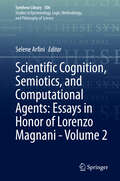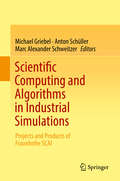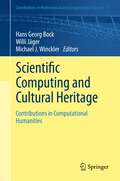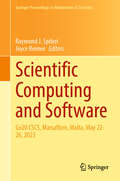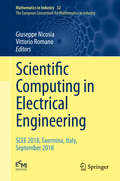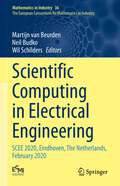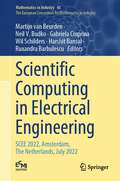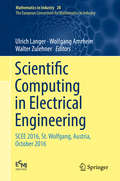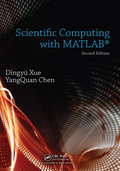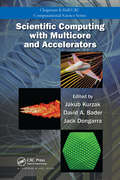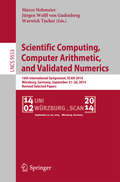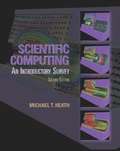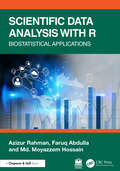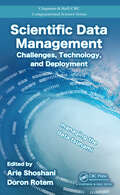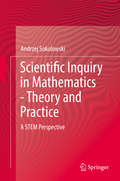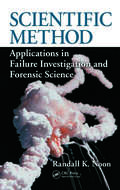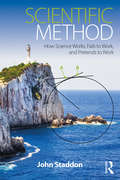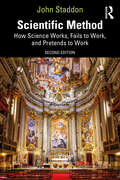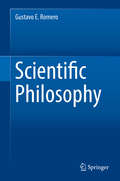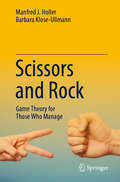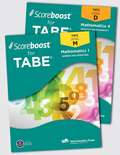- Table View
- List View
Scientific Cognition, Semiotics, and Computational Agents: Essays in Honor of Lorenzo Magnani - Volume 2 (Synthese Library #506)
by Selene ArfiniThis book, the second of two volumes, focuses on scientific cognition, computationalism, and scholars' reception of what Lorenzo Magnani named "eco-cognitive" views on the mind. The authors of these chapters address complex questions, which regard, in part, Magnani’s contributions in the field of model-based science, the role of inferential models in mathematics, the transformations and possible applicability of Charles Sanders Peirce’s and Immanuel Kant’s concepts and insight into current understanding of scientific progress, and the still unsolved questions regarding the methodological steps that take researchers to scientific discoveries. Some contributions also address the problematic understanding of artificial agents as "intelligent," how cognition can be discussed within the limits of computationalism, and how the eco-cognitive perspective on the mind also affects the conception of scientific reasoning and socially constructed phenomena. The book is of great interest to those interested in epistemology, philosophy of science, mathematical logic and AI.
Scientific Computing and Algorithms in Industrial Simulations
by Michael Griebel Marc Alexander Schweitzer Anton SchüllerThe contributions gathered here provide an overview of current research projects and selected software products of the Fraunhofer Institute for Algorithms and Scientific Computing SCAI. They show the wide range of challenges that scientific computing currently faces, the solutions it offers, and its important role in developing applications for industry. Given the exciting field of applied collaborative research and development it discusses, the book will appeal to scientists, practitioners, and students alike. The Fraunhofer Institute for Algorithms and Scientific Computing SCAI combines excellent research and application-oriented development to provide added value for our partners. SCAI develops numerical techniques, parallel algorithms and specialized software tools to support and optimize industrial simulations. Moreover, it implements custom software solutions for production and logistics, and offers calculations on high-performance computers. Its services and products are based on state-of-the-art methods from applied mathematics and information technology.
Scientific Computing and Cultural Heritage
by Willi Jäger Hans Georg Bock Michael J. WincklerThe sheer computing power of modern information technology is changing the face of research not just in science, technology and mathematics, but in humanities and cultural studies too. Recent decades have seen a major shift both in attitudes and deployment of computers, which are now vital and highly effective tools in disciplines where they were once viewed as elaborate typewriters. This revealing volume details the vast array of computing applications that researchers in the humanities now have recourse to, including the dissemination of scholarly information through virtual 'co-laboratories', data retrieval, and the modeling of complex processes that contribute to our natural and cultural heritage. One key area covered in this book is the versatility of computers in presenting images and graphics, which is transforming the analysis of data sets and archaeological reconstructions alike. The papers published here are grouped into three broad categories that cover mathematical and computational methods, research developments in information systems, and a detailed portrayal of ongoing work on documenting, restoring and presenting cultural monuments including the temples in Pompeii and the Banteay Chhmar temples of the Angkorian period in present-day Cambodia. Originally presented at a research workshop in Heidelberg, Germany, they reflect the rapidly developing identity of computational humanities as an interdisciplinary field in its own right, as well as demonstrating the breadth of perspectives in this young and vibrant research area.
Scientific Computing and Software: Go20 CSCS, Marsalforn, Malta, May 22-26, 2023 (Springer Proceedings in Mathematics & Statistics #495)
by Raymond J. Spiteri Joyce ReimerThese proceedings present a curated collection of innovative approaches to tackling challenging problems in applied mathematics. These problems, often marked by instability, inaccuracy, and high computational cost, remain at the forefront of mathematical research due to their difficulty. Addressing this demand, the contributions in this volume offer robust numerical methods designed to improve the accuracy and efficiency of their solutions. The book originates from the Go20 Conference 2023, where established experts and emerging researchers explored cutting-edge methodologies. The discussions captured here situate new advancements within a broader historical and theoretical context, providing a well-rounded perspective on these pressing mathematical challenges. Topics covered include: Ordinary Differential Equations (ODEs) with singularities Multi-dimensional and multi-rate systems of Partial Differential Equations (PDEs) High-index Differential-Algebraic Equations (DAEs) Inverse and optimal control problems This collection is a valuable resource for researchers and practitioners working on these or related topics. It offers comprehensive analyses and practical insights that bridge foundational principles with modern numerical innovations.
Scientific Computing in Electrical Engineering: SCEE 2018, Taormina, Italy, September 2018 (Mathematics in Industry #32)
by Giuseppe Nicosia Vittorio RomanoThis collection of selected papers presented at the 12th International Conference on Scientific Computing in Electrical Engineering, SCEE 2018, held in Taormina, Sicily, Italy, in September 2018, showcases the state of the art in SCEE.The aim of the SCEE 2018 conference was to bring together scientists from academia and industry, mathematicians, electrical engineers, computer scientists, and physicists, and to promote intensive discussions on industrially relevant mathematical problems, with an emphasis on the modeling and numerical simulation of electronic circuits and of electromagnetic fields. This extensive reference work is divided into five parts: Computational Electromagnetics, Device Modeling and Simulation, Circuit Simulation, Mathematical and Computational Methods, Model Order Reduction. Each part starts with a general introduction, followed by the respective contributions. The book will appeal to mathematicians and electrical engineers. Further, it introduces algorithm and program developers to recent advances in the other fields, while industry experts will be introduced to new programming tools and mathematical methods.
Scientific Computing in Electrical Engineering: SCEE 2020, Eindhoven, The Netherlands, February 2020 (Mathematics in Industry #36)
by Martijn Van Beurden Neil Budko Wil SchildersThe conference has an interdisciplinary focus and aims to bring together scientists – mathematicians, electrical engineers, computer scientists, and physicists, from universities and industry – to have in-depth discussions of the latest scientific results in Computational Science and Engineering relevant to Electrical Engineering and to stimulate and inspire active participation of young researchers.
Scientific Computing in Electrical Engineering: SCEE 2022, Amsterdam, The Netherlands, July 2022 (Mathematics in Industry #43)
by Martijn Van Beurden Wil Schilders Neil V. Budko Gabriela Ciuprina Harshit Bansal Ruxandra BarbulescuThis volume comprises selected papers presented at the 14th International Conference on Scientific Computing in Electrical Engineering, SCEE 2022, held in Amsterdam, The Netherlands, in July 2022. The aim of the SCEE 2022 conference was to bring together scientists – mathematicians, electrical engineers, computer scientists, and physicists, from universities and industry – to have in-depth discussions of the latest scientific results in Computational Science and Engineering relevant to Electrical Engineering and to stimulate and inspire active participation of young researchers.This extensive reference work is divided into four parts: Part I Circuit Simulation and Design.- Part II Device Simulation.- Part III Computational Electromagnetics.- Part IV Mathematical and Computational Methods. Each part starts with a general introduction, followed by the respective contributions. The book will appeal to mathematicians and electricalengineers. Further, it introduces algorithm and program developers to recent advances in the other fields, while industry experts will be introduced to new programming tools and mathematical methods.
Scientific Computing in Electrical Engineering: Scee 2016, St. Wolfgang, Austria, October 2016 (Mathematics In Industry Ser. #28)
by Ulrich Langer Wolfgang Amrhein Walter ZulehnerThis collection of selected papers presented at the 11th International Conference on Scientific Computing in Electrical Engineering (SCEE), held in St. Wolfgang, Austria, in 2016, showcases the state of the art in SCEE. The aim of the SCEE 2016 conference was to bring together scientists from academia and industry, mathematicians, electrical engineers, computer scientists, and physicists, and to promote intensive discussions on industrially relevant mathematical problems, with an emphasis on the modeling and numerical simulation of electronic circuits and devices, electromagnetic fields, and coupled problems. The focus in methodology was on model order reduction and uncertainty quantification. This extensive reference work is divided into six parts: Computational Electromagnetics, Circuit and Device Modeling and Simulation, Coupled Problems and Multi‐Scale Approaches in Space and Time, Mathematical and Computational Methods Including Uncertainty Quantification, Model Order Reduction, and Industrial Applications. Each part starts with a general introduction, followed by the respective contributions. This book will appeal to mathematicians and electrical engineers. Further, it introduces algorithm and program developers to recent advances in the other fields, while industry experts will be introduced to new programming tools and mathematical methods.
Scientific Computing with MATLAB
by YangQuan Chen Dingyu XueScientific Computing with MATLAB®, Second Edition improves students’ ability to tackle mathematical problems. It helps students understand the mathematical background and find reliable and accurate solutions to mathematical problems with the use of MATLAB, avoiding the tedious and complex technical details of mathematics. This edition retains the structure of its predecessor while expanding and updating the content of each chapter. The book bridges the gap between problems and solutions through well-grouped topics and clear MATLAB example scripts and reproducible MATLAB-generated plots. Students can effortlessly experiment with the scripts for a deep, hands-on exploration. Each chapter also includes a set of problems to strengthen understanding of the material.
Scientific Computing with Multicore and Accelerators (Chapman & Hall/CRC Computational Science)
by Jack Dongarra David A. Bader Jakub KurzakThe hybrid/heterogeneous nature of future microprocessors and large high-performance computing systems will result in a reliance on two major types of components: multicore/manycore central processing units and special purpose hardware/massively parallel accelerators. While these technologies have numerous benefits, they also pose substantial perfo
Scientific Computing, Computer Arithmetic, and Validated Numerics
by Warwick Tucker Marco Nehmeier Jürgen Wolff von GudenbergThis book constitutes the refereed post proceedings of the16th International Symposium, SCAN 2014, held in Würzburg, Germany, in September 2014. The 22 full papers presented were carefullyreviewed and selected from 60 submissions. The main concerns of research addressed by SCAN conferences are validation, verification or reliable assertions of numerical computations. Interval arithmetic and other treatments of uncertainty are developed as appropriate tools.
Scientific Computing, Computer Arithmetic, and Validated Numerics: 16th International Symposium, SCAN 2014, Würzburg, Germany, September 21-26, 2014. Revised Selected Papers (Lecture Notes in Computer Science #9553)
by Warwick Tucker Marco Nehmeier Jürgen Wolff von GudenbergThis book constitutes the refereed post proceedings of the 16th International Symposium, SCAN 2014, held in Würzburg, Germany, in September 2014. The 22 full papers presented were carefully reviewed and selected from 60 submissions. The main concerns of research addressed by SCAN conferences are validation, verification or reliable assertions of numerical computations. Interval arithmetic and other treatments of uncertainty are developed as appropriate tools.
Scientific Computing: An Introductory Survey
by Michael T. HeathThis book presents a broad overview of numerical methods for solving all the major problems in scientific computing.
Scientific Data Analysis with R: Biostatistical Applications
by Azizur Rahman Faruq Abdulla Md. Moyazzem HossainIn an era marked by exponential growth in data generation and an unprecedented convergence of technology and healthcare, the intersection of biostatistics and data science has become a pivotal domain. This book is the ideal companion in navigating the convergence of statistical methodologies and data science techniques with diverse applications implemented in the open-source environment of R. It is designed to be a comprehensive guide, marrying the principles of biostatistics with the practical implementation of statistics and data science in R, thereby empowering learners, researchers, and practitioners with the tools necessary to extract meaningful knowledge from biological, health, and medical datasets.This book is intended for students, researchers, and professionals eager to harness the combined power of biostatistics, data science, and the R programming language while gathering vital statistical knowledge needed for cutting-edge scientists in all fields. It is useful for those seeking to understand the basics of data science and statistical analysis, or looking to enhance their skills in handling any simple or complex data including biological, health, medical, and industry data.Key Features: Presents contemporary concepts of data science and biostatistics with real-life data analysis examples Promotes the evolution of fundamental and advanced methods applying to real-life problem-solving cases Explores computational statistical data science techniques from initial conception to recent developments of biostatistics Provides all R codes and real-world datasets to practice and competently apply into reader’s own domains Written in an exclusive state-of-the-art deductive approach without any theoretical hitches to support all contemporary readers
Scientific Data Management: Challenges, Technology, and Deployment
by Arie Shoshani Doron RotemDealing with the volume, complexity, and diversity of data currently being generated by scientific experiments and simulations often causes scientists to waste productive time. Scientific Data Management: Challenges, Technology, and Deployment describes cutting-edge technologies and solutions for managing and analyzing vast amounts of data, helping
Scientific Inference
by Aptara. Inc Simon VaughanProviding the knowledge and practical experience to begin analysing scientific data, this book is ideal for physical sciences students wishing to improve their data handling skills. The book focuses on explaining and developing the practice and understanding of basic statistical analysis, concentrating on a few core ideas, such as the visual display of information, modelling using the likelihood function, and simulating random data. Key concepts are developed through a combination of graphical explanations, worked examples, example computer code and case studies using real data. Students will develop an understanding of the ideas behind statistical methods and gain experience in applying them in practice.
Scientific Inquiry in Mathematics - Theory and Practice: A Stem Perspective
by Andrzej SokolowskiThis valuable resource provides an overview of recent research and strategies in developing and applying modelling to promote practice-based research in STEM education. In doing so, it bridges barriers across academic disciplines by suggesting activities that promote integration of qualitative science concepts with the tools of mathematics and engineering. The volume’s three parts offer a comprehensive review, by 1) Presenting a conceptual background of how scientific inquiry can be induced in mathematics classes considering recommendations of prior research, 2) Collecting case studies that were designed using scientific inquiry process designed for math classes, and 3) Exploring future possibilities and directions for the research included within. Among the topics discussed: · STEM education: A platform for multidisciplinary learning. · Teaching and learning representations in STEM. · Formulating conceptual framework for multidisciplinary STEM modeling. · Exploring function continuity in context. · Exploring function transformations using a dynamic system. Scientific Inquiry in Mathematics - Theory and Practice delivers hands-on and concrete strategies for effective STEM teaching in practice to educators within the fields of mathematics, science, and technology. It will be of interest to practicing and future mathematics teachers at all levels, as well as teacher educators, mathematics education researchers, and undergraduate and graduate mathematics students interested in research based methods for integrating inquiry-based learning into STEM classrooms.
Scientific Method: Applications in Failure Investigation and Forensic Science (International Forensic Science and Investigation)
by Randall K. NoonMost failure or accident investigations begin at the end of the story: after the explosion, after the fire has been extinguished, or after the collapse. In many instances, information about the last event and the starting event is known reasonably well. Information about what occurred between these endpoints, however, is often unclear, confusing, and perhaps contradictory. Scientific Method: Applications in Failure Investigation and Forensic Science explains how scientific investigative methods can best be used to determine why and how a particular event occurred.While employing examples from forensic engineering, the book uses principles and ideas applicable to most of the forensic sciences. The author examines the role of the failure investigator, describes the fundamental method for investigation, discusses the optimal way to organize evidence, and explores the four most common reasons why some investigations fail. The book provides three case studies that exemplify proper report writing, contains a special chapter profiling a criminal case by noted forensic specialist Jon J. Nordby, and offers a reading list of resources for further study.Concise and illustrative, this volume demonstrates how the scientific method can be applied to failure investigation in ways that avoid flawed reasoning while delivering convincing reconstruction scenarios. Investigators can pinpoint where things went wrong, providing valuable information that can prevent another catastrophe.
Scientific Method: How Science Works, Fails to Work, and Pretends to Work
by John StaddonThis book shows how science works, fails to work, or pretends to work, by looking at examples from such diverse fields as physics, biomedicine, psychology, and economics. Social science affects our lives every day through the predictions of experts and the rules and regulations they devise. Sciences like economics, sociology and health are subject to more ‘operating limitations’ than classical fields like physics or chemistry or biology. Yet, their methods and results must also be judged according to the same scientific standards. Every literate citizen should understand these standards and be able to tell the difference between good science and bad. Scientific Method enables readers to develop a critical, informed view of scientific practice by discussing concrete examples of how real scientists have approached the problems of their fields. It is ideal for students and professionals trying to make sense of the role of science in society, and of the meaning, value, and limitations of scientific methodology in the social sciences.
Scientific Method: How Science Works, Fails to Work, and Pretends to Work
by John StaddonThis expanded second edition of Scientific Method shows how science works, fails to work or pretends to work by looking at examples from physics, biomedicine, psychology, sociology and economics.Scientific Method aims to help curious readers understand the idea of science, not by learning a list of techniques but through examples both historical and contemporary. Staddon affirms that if the reader can understand successful studies as well as studies that appear to be scientific but are not, they will become a better judge of the “science” in circulation today. To this end, this new edition includes a new chapter, What is Science?, which points out that science, like any human activity, has its own set of values, with truth being the core. Other new chapters focus on the emergence of AI and machine learning, science and diversity, and behavioral economics. The book also includes textual features such as bullet-points and text boxes on topical issues.Scientific Method is essential reading for students and professionals trying to make sense of the role of science in society, and of the meaning, value and limitations of scientific methodology.
Scientific Philosophy
by Gustavo E. RomeroThis textbook presents the basics of philosophy that are necessary for the student and researcher in science in order to better understand scientific work. The approach is not historical but formative: tools for semantical analysis, ontology of science, epistemology, and scientific ethics are presented in a formal and direct way. The book has two parts: one with the general theory and a second part with application to some problems such as the interpretation of quantum mechanics, the nature of mathematics, and the ontology of spacetime. The book addresses questions such as "What is meaning?", "What is truth?", "What are truth criteria in science?", "What is a theory?", "What is a model?" "What is a datum?", "What is information?", "What does it mean to understand something?", "What is space?", "What is time?", "How are these concepts articulated in science?" "What are values?" "What are the limits of science?", and many more. The philosophical views presented are "scientific" in the sense that they are informed by current science, they are relevant for scientific research, and the method adopted uses the hypothetical-deductive approach that is characteristic of science. The results and conclusions, as any scientific conclusion, are open to revision in the light of future advances. Hence, this philosophical approach opposes to dogmatic philosophy. Supported by end-of-chapter summaries and a list of special symbols used, the material will be of interest for students and researchers in both science and philosophy. The second part will appeal to physicists and mathematicians.
Scientific Research and Methodology: An Introduction to Quantitative Research and Statistics
by Peter K. DunnThis textbook is designed for teaching quantitative research in the scientific, health and engineering disciplines at first-year undergraduate level, with an emphasis on statistics. It covers the research process, including asking research questions, research design, data collection, summarising data, analysis and communication. Many real journal articles are used throughout the text as examples that demonstrate the use of the techniques.Students are introduced to statistics as a method for answering questions. Descriptive research questions lead to analysis of single proportions and means. Repeated-measures research questions are answered using paired quantitative data. Relational research questions compare proportions, odds and means in different groups. Correlational research questions are studied using correlation and regression techniques.Statistical topics include numerical summary methods (such as means, odds ratios and identification of outliers), graphing (such as histograms, case-profile plots and scatterplots), confidence intervals and hypothesis testing. Emphasis is placed on understanding and concepts; while calculations are shown in simple situations, they are deferred to software when the computations become tedious and disruptive to understanding.Almost every dataset used is a real dataset, and is available online or in an associated R package SRMData. Software output is often used when calculations become onerous. The output is sufficiently generic that the book can be used in conjunction with any statistical software.
Scissors and Rock: Game Theory for Those Who Manage
by Manfred J. Holler Barbara Klose-UllmannThis book introduces readers to basic game theory as a tool to deal with strategic decision problems, helping them to understand the complexity of such problems – to extract a solution, if possible – and to manage the complexity by revising the game if appropriate. The authors discuss basic decision situations modeled as Prisoners’ Dilemma, Chicken Game, and Stag Hunt Game, as well as concepts like the Nash equilibrium, Trembling Hand Perfectness, Rationalizable Strategies and the Theory of Moves to introduce game theoretic thinking. Further, the book presents pioneers of strategic thinking, e.g., Sun Tzu, Machiavelli, Adam Smith, and Goethe, and includes cases of conflict and cooperation to illustrate practical applications. Readers learn to apply game theory in business and in daily life – to manage their decision problems and to better understand the decision problems of others.
Scoreboost for TABE Level M Mathematics 2: Measurement, Data And Geometry
by New PressScoreboost® for TABE® Level M Mathematics 2: Measurement, Data, and Geometry
Scoreboost for TABE Mathematics 1: Numbers and Operations
by New PressAligned to TABE 11/12, each workbook features targeted instruction in an easy-to-follow format: strategy, example, guided practice, independent practice, and TABE practice. Each workbook ends with a TABE practice test to ensure TABE-readiness.
